All about ultrasonic toothbrushes

The state of the oral cavity directly depends on the quality and regularity of sanitary procedures. Traditional brushes cannot always cope with cleaning hard-to-reach areas and completely remove plaque - this leads to serious dental problems. To prevent them, dentists recommend using ultrasonic teeth cleaning.



Device and principle of operation
An ultrasonic oral brush is an electrical appliance designed for the treatment of gums and teeth. The device is classified as professional. Cleaning is carried out due to the impact of vibrational waves on the smallest fibers of the brush - this is the main difference between such hygiene products from traditional products. A motor is provided inside the device, and a piezoceramic plate is located under the bristles. It vibrates in the 1.6-1.7 MHz frequency range, which causes the vibrational movement of the villi at a speed of up to 100 million rotations per minute. Due to this vibration frequency, the full penetration of ultrasonic waves into the depths of the gums and teeth by 3 mm is ensured.
When operating an ultrasound brush with rotating bristles, the soft and hard tissues of the oral cavity are warmed up by 1-2 degrees. Users can experience a slight warmth. When the temperature rises, the process of releasing nutrients from the paste is accelerated - this leads to an improvement in blood circulation in the gums, and also strengthens the tooth enamel. Today, ultrasound machines are increasingly replacing traditional devices.This is not surprising, because they provide a high effect of cleansing the oral cavity.
The stores offer a wide range of dental hygiene products of various quality and price categories. They differ in technical and operational characteristics and appearance.



Advantages and disadvantages
Among the main advantages of ultrasonic dental devices are the following:
- exceptional cleaning efficiency;
- high result for teeth with sensitive enamel;
- uniform removal of plaque;
- performing gum massage, improving the process of blood circulation in soft tissues;
- brightening the enamel by 2-4 tones;
- a high degree of penetration of useful components of the toothpaste into the tissues of the oral cavity;
- preservation of enamel;
- minimum consumption of paste;
- high speed of cleansing.

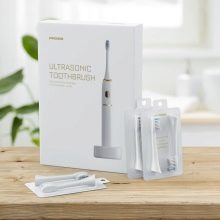

However, they have their drawbacks. They appear if the device is used incorrectly:
- high risk of falling out of fillings;
- if the mineral layer is destroyed on the tooth enamel, then there is a high risk of deterioration of the condition of the teeth;
- the need for constant replacement of nozzles;
- high price of the device itself and its components.



Indications and contraindications
When using an ultrasonic brush, you can quickly and effectively clean the gaps between teeth, periodontal sulci, periodontal pockets and other hard-to-reach areas. Regular hygiene of the oral cavity with the help of ultrasound frees the teeth from dense layers and destroys the mineralized plaque. As a result, the surface of the teeth becomes smoother and whiter. However, this tool must be used with great care: there are a number of contraindications to the use of ultrasound.
So, with periodontitis, purulent sacs and cysts often appear in the oral cavity. Patients may not even suspect that they have such a pathology, since it makes itself felt only when the immunity is weakened. If the infection is chronic, then the use of ultrasonic brushes threatens with an exacerbation of the disease.
Taking into account that, according to statistics, more than 70% of people face such problems, the uncontrolled use of such devices is not recommended.



In acute inflammation of the gums (periodontitis), the use of ultrasound for dental treatment is strictly prohibited. The use of physiotherapy is possible only in the absence of swelling, bleeding and suppuration. Accelerating blood circulation in soft tissues, ultrasound promotes the rapid spread of infection - this leads to increased swelling and increased pain symptoms. With such a pathology, the ultrasonic brush can only be used after a course of therapy and subsequent professional cleaning.
And here in chronic periodontitis, ultrasound is not recommended even after cleaning by a doctor. The fact is that this pathology leads to the destruction of bone tissue and its gradual replacement with granulation. Wave radiation will accelerate this process, as a result, the teeth will become mobile and begin to fall out. Therefore, in no case should you trust an advertisement that promises that ultrasound treatment can cope with periodontal disease.



High-frequency vibrations of an electric toothbrush penetrate deep into the dental tissue and cause fillings to vibrate. In strong teeth, the tissues are homogeneous, and the waves, accordingly, are also evenly distributed in them. In seals, vibrations are distributed according to a different pattern. The mismatch of vibration waves leads to a conflict between the insert and natural fabrics, impairing the adhesion between them. All this sooner or later leads to the loss of the orthodontic inlay.
White spots can be seen on the teeth of some clients - these are nothing more than foci of demineralization, they are the first symptom of carious lesions. In such places, tooth enamel is especially fragile.Despite the fact that its destruction is hardly noticeable, in these conditions, only an experienced doctor can competently clean the damaged areas without affecting the damaged areas. When exposed to the focus of demineralization with ultrasound, the outer layer of enamel begins to crumble, and subsequently such a tooth will have to be filled.
One important conclusion can be drawn: the ultrasonic brush gives a good effect only for people with absolutely healthy teeth, without pathologies of the gums, fillings and crowns.
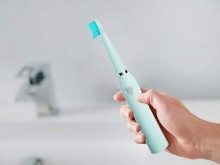


Besides, the use of ultrasound processing of the oral cavity is not recommended for expectant mothers. It is known that any dental treatment at the beginning of pregnancy often leads to miscarriage. There is no proven fact that an ultrasonic brush is harmful. Nevertheless, doctors do not recommend the use of such a device for women in position. People with diabetes mellitus, pacemaker and cancer should also refrain from using an electric toothbrush.
Many parents are interested in the question of whether it is possible to use an ultrasonic brush for children. Yes, electric models are intended for use from 5 years of age. The ultrasound device is suitable for children, because with their help, babies can effectively clean the surface of the teeth, at the same time and massage the gums.
Important: for young users, specialized models have been developed taking into account the age characteristics of the formation of teeth. It is not recommended to use adult devices for children under 12 years of age.



Comparison with other species
In comparison with traditional mechanical toothbrushes, ultrasonic ones do their job much better, since double cleaning works. Here mechanical action is combined with high-frequency treatment, which gives a high therapeutic effect. It is impossible to achieve such a result with a simple device, ultrasound devices protect the oral cavity from bacteria much better and remove plaque faster. In addition, such brushes operate in a gentle mode.
Ultrasonic brushes are often compared to electric ones. These models have a similar principle of operation, but nevertheless there is a difference between them. Electric work from a drive, which, under the action of an electric current, causes the cleaning head to vibrate. The villi produce reciprocating or pulsating movements, thereby effectively eliminating plaque. An ultrasound brush is an improved version of such a device. The movement of the villi here occurs under the action of ultrasound, which allows the model to better cope with even the most hard plaque.



Rating of the best models
We offer a small overview of the top 5 most popular ultrasonic toothbrushes.
Donfeel HSD-010
Ultrasonic device designed to clean hard-to-reach areas of the oral cavity. It has several operating modes, provides improved cleaning quality, quick removal of dirt and deposits. The device is electric, however, when using it, the effect of harmful electromagnetic radiation is completely excluded. It differs from similar models in the presence of a disinfectant that cleans the bristles from all pathogenic microbes and bacteria. Unlike many other models, this brush can be used for the hygiene of veneers, crowns, implants and other orthodontic structures.
Pros:
- powerful battery;
- gentle cleaning of tooth enamel without damaging soft tissues;
- the ability to select operating modes;
- gum massage function;
- economical use of toothpaste;
- the ability to remove mineralized plaque;
- pronounced whitening effect.
Minuses:
- high price;
- impressive dimensions of the cleaning head;
- lack of spare nozzles in the kit;
- the duration of the battery charging.
In addition, the support of such a brush is large and therefore takes up a lot of space.
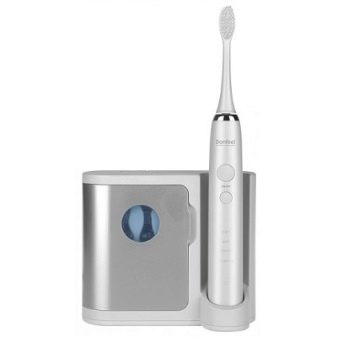

Asahi Irica AU300E
A Japanese ultrasonic device that effectively softens and removes tartar, soft bacterial deposits and plaque. Made of glossy plastic, includes silicone inserts. The brush is activated via a button located on the handle of the device.
There is a choice of operating modes:
- AUTO - designed for standard cleaning of the oral cavity using mechanical vibrations combined with ultrasound;
- U-Sonic - gentle mode with reduced vibration, is used to treat sensitive tooth enamel and lightly massage the gums.
The body of the toothbrush is waterproof.
Pros:
- practicality and reliability of the device;
- long operational period;
- ease of use;
- the ability to massage soft tissues;
- availability of storage cases;
- stylish design;
- fast battery charging;
- the inability to damage the gums.
Minuses:
- if used incorrectly, causes the loss of seals and implants;
- high noise level during device operation;
- the high cost of the brush itself and all accessories;
- the need for frequent replacement of nozzles.


Acleon F36
German-made ultrasonic brush. The device has a stylish ergonomic design and impeccable functionality. Available in two colors: white and black. There is a timer for 120 seconds - this time is considered optimal for performing high-quality cleaning of the oral cavity. Additionally, the timer can be set for a different time, for example, 30 seconds, so that it prompts when to move on to the treatment of another part of the oral cavity.
This ultrasound penetrates deeply into the tooth enamel and qualitatively cleans the enamel from dirt and plaque. The toothbrush of this brand allows you to clean even the most inaccessible areas and thereby prevents the development of carious foci. The set includes 3 conventional tips and 2 intended for processing orthodontic structures. There is a built-in disinfector.
Pros:
- the ability to choose one of 4 cleaning modes;
- soft massage of the gums;
- gentle whitening;
- autonomous work up to 10-14 days;
- disinfecting case with UV lamp;
- fast battery charging;
- a large set of nozzles;
- timer.
No disadvantages were identified.
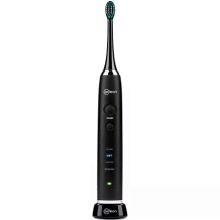

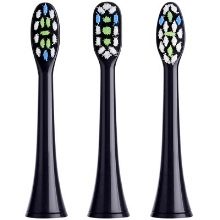
Xiaomi Ultrasonic Toothbrush
This brush is used for professional care. The device is made of high quality materials, due to which it most effectively and at the same time carefully cleans the tooth enamel from pathogenic microorganisms. Switching the operating mode can be done through a special application installed on the smartphone. And also through the phone, you can connect various additional options, for example, to analyze the quality and effectiveness of brushing your teeth.
Pros:
- high efficiency of hygiene procedures;
- compactness and light weight;
- mobility;
- built-in moisture protection;
- safety for children and adults;
- noiselessness of work;
- the ability to control from a smartphone;
- auto shutdown.
The disadvantages include:
- lack of replaceable attachments included;
- the risk of erasing tooth enamel;
- a large number of contraindications for use.


Soocas X3 Inter Smart Ultrasonic Toothbrush White
This device has an ergonomic grip and a durable, durable cover. The powerful battery allows you to clean your mouth in just 2-3 minutes. Provides 4 modes of operation:
- the first is used for everyday use;
- the second is for teeth with sensitive enamel;
- the third one gives a good result for teeth whitening;
- the fourth allows you to set the settings yourself.
Thanks to the rich functionality, you can take care of the oral cavity, remove soft and mineralized plaque, and suspend the activity of pathogenic bacteria. One of the distinguishing characteristics of the device is its villi - they are made of an elastic material and have a very small cross-section in the section.This determines the safety of using the drug, such cleaning does not injure either the enamel or the gums.
Pros:
- convenient shape and size of the working head;
- does not leave micro-scratches on the tooth enamel;
- protection against water ingress is provided;
- ultra-fine bristles;
- increased vibration;
- the ability to synchronize with a gadget;
- long operational period;
- quick charge option.
Disadvantages:
- the battery is charging slowly;
- when used, the paste is sprayed on the sides;
- high price.


Nuances of choice
When choosing an ultrasonic toothbrush for yourself, you need to pay attention to a number of characteristics.
- Availability of additional functions. Pressure sensors, a wear indicator, a timer, a function of getting used to the device and an irrigator - all this allows not only to simplify the hygiene procedure, but also to make it as comfortable as possible. However, there is no point in overpaying for devices equipped with functions that you are unlikely to need.
- Working head size and bristle stiffness. Typically, ultrasonic brushes are equipped with medium-hard bristles and an elongated head. Such devices are optimal for people with healthy teeth. Users with increased enamel sensitivity are better off opting for soft bristles and a rounded working head.
- Type of food. Various models of ultrasonic brushes can operate on batteries or rechargeable batteries. Therefore, when choosing a particular model, you should take into account your preferences: some people like devices that require connection to the electrical network, others like mobile devices.
- User's age. Products intended for babies do not give a noticeable effect when used by adults - the amount of vibrations in them is much less, and they cannot properly clean the oral cavity of an adult. For children, it is worth choosing lightweight compact models, they are comfortably held in the hand, do not slip out and are safe.
- Manufacturers. In modern stores, you can find budget sonic brushes made in China or Korea. However, dentists advise against buying them. It is better to give preference to devices from reliable and trusted manufacturers who will guarantee the quality of their products and their durability.
The most famous brands in this segment are Oral-B, Panasonic and Philips.


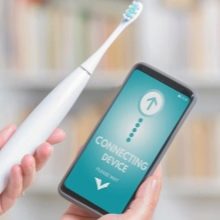
How to brush your teeth properly?
Instructions for using ultrasound-based brushes are practically no different from all the rules and requirements that apply to their electrical varieties. The algorithm for treating the oral cavity can be divided into several stages. The first step is to rinse your mouth with water to remove large food debris from the tooth enamel. After that, the toothbrush is moistened and a little paste is applied to it. Next, turn on the device and perform cleaning. It is necessary to process not only the front, but also the back of the teeth, special attention should be paid to the chewing surfaces.
At the end of the procedure, the oral cavity is rinsed again with water or a special dental solution. Cleaning with an ultrasonic brush takes a couple of minutes, it takes 2-3 seconds for each tooth, molars and chewing teeth with a large number of grooves and irregularities are cleaned a little longer.



To achieve the desired effect from the use of ultrasound, you need to adhere to certain rules:
- before using the brush, make sure that the battery is charged;
- teeth need to be brushed 2 times a day with a small amount of paste;
- to clean the inner, outer and lateral surfaces of the teeth, the brush is used at an angle of 45 degrees;
- while brushing the front teeth, the device is held vertically;
- when brushing chewing teeth, the brush is kept in a horizontal position;
- processing should be carried out in such a way that the bristles affect both hard and soft tissues;
- after cleaning the oral cavity, the villi must be thoroughly rinsed and disinfected.
Advice: keep an eye on the state of charge of the battery, change the batteries regularly so that the device is in functional condition at any time. To avoid damage to the device, do not immerse it in water.


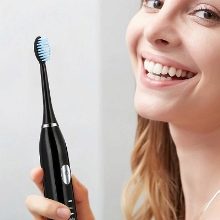
Review overview
Nowadays, ultrasonic cleaning of teeth at home has become available to anyone. It helps to remove plaque, whitens teeth and stops the development of pathogenic microflora. However, not all users are ready to call such a brush the result of technical progress. Such devices are only good for people with perfectly healthy teeth. Unfortunately, these days they are more of a rarity than a rule.
In the presence of any pathologies with teeth or gums, inflammatory processes develop much more actively. They lead to a constant feeling of pain and aching teeth. Therefore, experts do not recommend using these brushes on a permanent basis.











